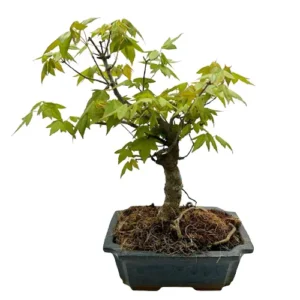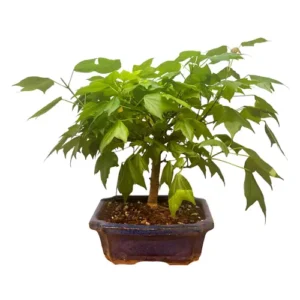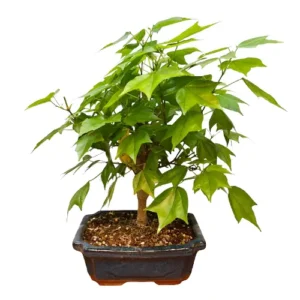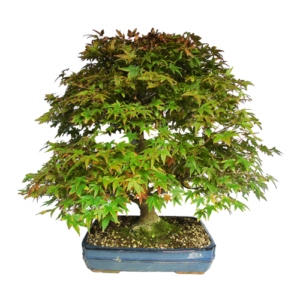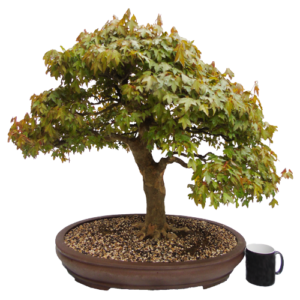Trident Maple Bonsai Tree (Acer buergerianum) is a popular outdoor species. Trident Maples grow fast and are easy to train, with leaves that change color
Trident maple (Acer buergerianum)
Placement
Choose an outdoor location that is sunny but protected from strong wind and scorching sunlight in the hottest part of summer days. Despite being frost hardy; Trident maple bonsai trees should be protected from sustained freezing and intense frost so protect your bonsai tree from temperatures below -5 °C by moving it to an unheated greenhouse or conservatory, or providing insulation during winter. Remember to monitor weather conditions and adjust the placement of your bonsai tree accordingly to ensure its health and vitality throughout the year.
Watering
There is no definitive guide to watering and it should be conducted on an observational schedule, not a routine. This means that it is important to keep an eye on the moisture levels of the soil to avoid over and under watering, both which can lead to dropping leaves and/or root death. The amount of water a bonsai requires depends on pot size, climate, airflow, soil and tree type so it is best to use your eyes and fingers to assess whether the soil is damp, wet or dry. As a general guide, if the top inch or so has dried, it is ready to be watered. When you water, ensure an even coverage over the roots and soil, allowing water to flow out from the bottom of the pot to allow for a good soaking. Never let the soil dry out completely and never let your bonsai sit in water for long periods of time.
During the spring and summer growing months, Trident maple bonsai tree require a large amount of water which could mean watering twice a day. There is not much danger of overwatering during these months as long as a well-draining compost has been used, but take care to use the bare minimum of water during the winter months when the leaves are not photosynthesising.
Fertilising
Using fertiliser on your Trident maple will help encourage healthy growth and this should be done periodically from once a week to every two months and only during the growing season. You can start adding nutrients to your water from March until October and use weekly. If using solid fertilizer, use once every one to two months. With trident maple bonsai trees, less is more and we tend to advise using half the recommended dosage to see how your bonsai reacts first.
Pruning and wiring
Pruning your bonsai is important not only to create or maintain an aesthetic style but to also ensure light and airflow can reach inner leaves and the shoots and twigs of the Trident maple can and should be trimmed all year round. During the early to late spring months use appropriate tools to cut back stems which have grown longer than four leaves, leaving the two leaves which are closest to the stem intact. Save any pruning or cutting of the stronger branches until autumn to prevent bleeding and be sure to use a use wound closure agent since maples are particularly prone to fungal infections. Remove large leaves during periods of active growth to encourage the appearance of smaller and finer leaves.
Training your trident maple bonsai treeusing wiring is best done when the tree is in leaf since branches that contain more sap are less likely to snap. Monitor any wiring carefully to ensure that the wire does not become embedded in the bark as the tree grows vigorously over the spring to summer periods. Guy wires are a good option for older and stiffer branches.
Repotting
Repotting your tree is an important way to provide a fresh and suitable soil mix and ensure appropriate root health. As a general rule, your Trident maple will need to be re-potted every other year, and only in spring, but you should check if it has become root-bound before you change pots. You can do this by lifting the tree gently out of the pot by the main trunk, and examining the root system. You will know it is ready if you can see that the roots are circling around each other and the pot. If, however they still appear contained in the soil, you should place it back and wait until the following spring to check again. Maples have a strong and vigorous root system that tolerates heavy pruning and you can cut back the roots aggressively, removing about 30-50% of the root mass to encourage new growth.
Showing all 6 results

